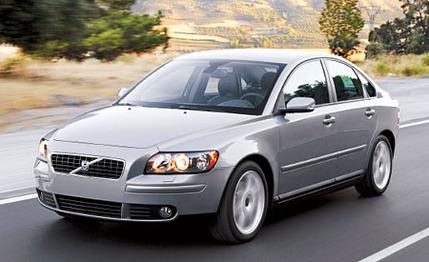
 First Drive Review
First Drive Review
One shift into our driving experience with the all-new S40, and we realized Volvo's second-generation small car had taken a big step toward becoming a driver's machine. That's because now it can actually be shifted by the driver. Unlike its predecessor, which came only with a four-speed automatic teamed with a 170-hp, 1.9-liter turbo four-cylinder, this latest Swede can be equipped with a five- or six-speed manual transmission, or a five-speed automatic, and a pair of inline five-cylinder engines making 168 and 218 horsepower, respectively.
We knew the new S40 meant business even before we got behind the wheel. A ringer for a stubbier S60, the S40 looks as if it had spent many a long winter's night at a Swedish gym. Examine the fresh next to the stale, and the new car appears more athletic, highlighted by short overhangs and bulging fenders. It is aggressive where the previous car was timid. More important, it now looks like a Volvo. Perhaps it bears too much family resemblance to the S60, but overall, it's a sportier, welcome guise.
Compared with the previous S40, the new car is 1.9 inches shorter, yet is 2.1 inches wider and 1.5 inches taller. It rides on a wheelbase that is 3.1 inches longer and has wider front and rear tracks. As a result, every interior dimension-sans rear headroom, which remains 37.2 inches-has increased, including a much-needed 1.7-inch hike in rear legroom.
Volvo's "smaller without getting less" philosophy not only resulted in an interior that is bigger but one that is more stylish and functional. Bissecting the dash is a unique, aluminum-covered center stack that is less than an inch thick. It looks like a chic Nambé platter, and it houses all the audio, telephone, and climate controls, while also shielding a convenient storage bin behind it. Ergonomically, the button-and-knob-infused stack isn't immediately intuitive, but a few minutes of study make it a quick learn. Once mastered, the controls become a second thought to the appreciation garnered from the top-level fit and finish and high-quality materials. Despite being an "entry level" car, the S40 feels as refined and luxurious as the upper-echelon S60.
Although Volvo designed the S40, it can't take full credit for developing the car, which shares architecture with the Mazda 3 and next-generation Ford Focus. Engineers from Ford, Mazda, and Volvo collaborated on the C1 platform, contributing to and drawing from the development pool. The fruits of this labor came to be known as "global shared technologies," or the basic components-underbody, suspension layout, steering, etc.-utilized by the three brands. According to a Volvo engineer, the shared components consist of "everything that doesn't make the brand." In other words, Ford and Mazda couldn't grab everything they wanted from Volvo's safety bag.
As with all Volvos, that bag is full of comforting things, including front, side, and curtain airbags; collapsible pedals; seatbelt pretensioners; whiplash protection; and four grades of steel for the frontal structure to create optimal crumple zones. Volvo even went so far as to simulate frontal crash tests without the engines installed, forcing engineers to shave 7.8 inches from the width of the transverse motors so they'd fit within the space that remained after the test. Moreover, the S40, whose body is 68 percent stiffer than its predecessor's, gets standard traction control and four-wheel disc brakes with ABS and emergency brake assist, as well as optional dynamic stability control.
Our favorite preview example-a front-wheel-drive T5-came with the turbocharged 2.5-liter inline five-cylinder used in the S60, S80, and XC90, mated to the six-speed manual from the S60R. Featuring short throws and light, effortless action, the gearbox makes it easy to enjoy and maximize the T5's 218 horsepower and 236 pound-feet of torque. Volvo says the T5 can hit 60 mph in 6.3 seconds and produce a top speed of 149 mph. With all that torque available from 1500 to 4800 rpm, the T5 not only launches off the line but also quickly gets out of its own way on the highway, exhibiting no noticeable turbo lag. There's also little torque steer evident, which is impressive considering all the twist being delivered through the front tires. An all-wheel-drive T5, using the V70 AWD's Haldex system, will be available, but it almost seems superfluous given that the front-driver performs so well.
The other, less favorable example we sampled was a base 2.4i automatic that featured a naturally aspirated 168-hp, 2.4-liter five mated to a five-speed Geartronic. Judged against the harelike T5, the 2.4i felt like a tortoise on Xanax. Volvo estimates 8.4 seconds for 0 to 60, more than two seconds slower than the T5 manual. The 2.4i's available five-speed manual would likely liven up the car, but not enough to make us even think of exiting the T5's driver seat.
Both S40s use struts up front and a multilink setup in the rear, tuned for a firm ride that manages to be both comfortable and compliant. Our cars' Euro settings felt ideal, making us wishful that Volvo wouldn't tinker with them for the U.S. cars. Complemented by communicative and linear steering-the best of any Volvo to date-and the optional 205/50R-17 tires on our T5, the able suspension made short work of the winding roads around Málaga, Spain.
Built at Volvo's Ghent factory in Belgium, the base and T5 S40s go on sale this spring, available only with the automatic transmission and front-wheel drive. Manual models and all-wheel-drive T5s will follow in the summer, when they'll receive 2005 monikers. Volvo says pricing should start at about $24,000 for a base 2.4i and top out at roughly $30,000 for a loaded T5. To us, that's reasonable pricing for a car that quantum-leaps its predecessor. Is it a big enough leap to reach Volvo's sales target of 28,000 units for 2004? We think so.